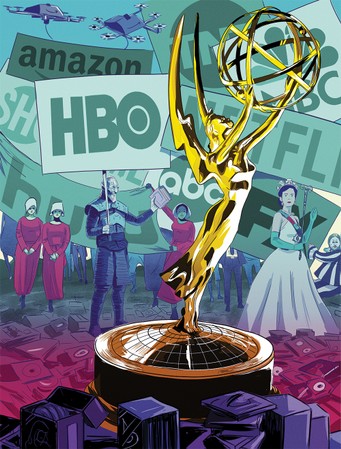Emmys: Campaigning in Peak TV Era Requires Bold Creativity
By Daniel Holloway
LOS ANGELES (Variety.com) – Peak TV has yet to peak.
According to research from FX Networks, 2017 saw a record-breaking 487 original scripted series premiere across broadcast, cable and streaming services. That number represents a 7% increase from 2016, and a 125% increase from 2012.
The dramatic increase in the volume of original programming has transformed the TV business — and is itself a product of the proliferation of first basic-cable channels, then subscription video platforms. One of the many side effects of the recent programming boom is that it has become impossible for anyone to keep up — especially Emmy voters.
“What I fear is happening in this new golden age of TV, with its hundreds of choices, is the Emmy voting body has become so overwhelmed with programming that they are unwittingly keeping under-the-radar shows, performances and craft artists from getting any gold,” says awards marketing consultant Richard Licata, CEO of Licata & Co. and a former communications exec at HBO, Fox, Showtime and NBC. “The white-noise curse has set in.”
In recent weeks, this “curse” has manifested itself in the mailboxes of Academy members, who have been inundated with screeners. Some companies, attempting to stand out, have sent entire seasons instead of the traditional sample episodes — making it impossible for voters to watch everything they receive.
To combat the challenges that come with campaigning in the peak TV era, Licata says, campaigns need to become year-round.
“In a crowded environment, a show needs to launch boldly and find a place in the cultural zeitgeist,” Licata says. “It’s not all about ads and screenings and May and June. The kind of show that serendipitously aligned with the political climate — or its tonic, the series your friends and families are chatting about at dinner parties, on talk shows, critical acclaim that triggers journalistic conversation, the one that begins racking up trophies at the various award soirees en route to the Emmys. Those shows exponentially increase their chances of making it into the Emmy derby.”
Scheduling also has an impact, as Jonathan Taylor, co-principal of Robertson Taylor Partners, notes.
“Hulu put out the second season of ‘The Handmaid’s Tale’ and Amazon put out the fourth season of “Bosch” just in the last few weeks, trying to keep those shows fresh in voters’ minds when it comes time to nominate,” Taylor says.
“The Handmaid’s Tale” premiered in April last year, then went on to win eight , including drama series and drama actress for Elizabeth Moss. “Game of Thrones,” meanwhile, faces a potential fight in its return to Emmy contention after airing outside of last year’s eligibility window. The most recent season aired in July and August of last year, while its competitors “The Handmaid’s Tale,” “This Is Us” and “The Americans” will be much fresher in members’ minds going into the voting period.
The other key ingredient to a successful campaign, Licata adds, is “aggressive, passionate talent participation for editorial coverage.” He notes that recognition from the Globes, through courtship of the Hollywood Foreign Press Assn., can be an entryway into the Emmy conversation.
If the Globes are a momentum-builder, no show may have benefited more than “The Marvelous Mrs. Maisel,” which won for comedy series and star Rachel Brosnahan for comedy series actress. “The Crown” star Claire Foy won for female actor in a drama series at the SAG Awards in December for the second year in a row, building her case as an Emmy contender.
Licata also stresses the need to stand out while staying cost efficient.
“Most campaigns are either hamstrung financially or creatively,” he says. “There’s an urgent need to think of innovative ideas that will capture voter attention beyond the traditional mailers, ads and screenings. Something that makes your eyes widen with curiosity and sends you to your TV.”
As an example, he points to Hulu’s deployment in public last year of large groups of women dressed as handmaids from “The Handmaid’s Tale.” “Those red, oppressive smocks from got pulses going,” he says.
But there are staples of the awards circuit that are not nearly as effective in the Peak TV era as some seem to think.
“It really feels like a yearly playing of the ‘Sorcerer’s Apprentice’ with boxed sets first seeming really awesome until they overtake your home or office,” Taylor says of the wealth of physical screeners that awards voters are bombarded with.
Netflix infamously sent four boxes of screeners last year that together weighed more than 40 pounds.
“It’s too much, but few want to forego the impact of a well-designed set,” Taylor adds.
And in an era of easy access to streaming video, screening events may also yield diminishing returns.
“In a crowded environment, a show needs to launch boldly and find a place in the cultural zeitgeist.”
Richard Licata
“They’re great for a night out to see your favorite stars and eat, drink and network,” Licata says. “But here’s the best-kept fact — there are 20,000-plus voting members of the TV Academy. If you host a screening or panel in 600-seat theater like the Wolf Theatre or the DGA where every member is invited to bring a guest, chances are that guest is not a voter.”
Licata estimates that a best-case scenario for a screening is 450 actual voters — less than 3% of the Emmy votership. And a typical screening costs $30,000-$50,000.
This year, the Academy has scheduled competing events on the same night, meaning that the pool for potential attendees will shrink for each respective event.
“Screening zealots will argue that every vote counts, and they’re right,” he says. “But if you have a show that doesn’t have an Emmy prayer, the only rationale to spend that kind of money is to keep the talent happy.”
This year, Netflix and Amazon — two of the most deep-pocketed competitors in the awards field — have attempted to solve multiple challenges by setting up their own dedicated spaces for FYC events.
“They have so many shows that they’re pushing, they can cater to each show that they have, give each one a platform, and at the same time cut through the clutter in a creative way,” says Michele Robertson of Michele Robertson Communications.
Licata notes that a solid campaign, factoring in a mailer, TV Academy fees, advertising and talent-participation costs can run $750,000-$1.5 million. That spend is the cost of doing business in an era of more shows than a person could be expected to watch.
“They have evolved significantly to accommodate an ever-expanding TV universe,” Licata says of Emmy campaigns. “In the past 18 years we’ve morphed from VHS to DVD to online screening availability for voters. We’ve gone from modest FYC advertising in the print trades to an ocean of digital ads appearing on various entertainment websites, in addition to billboards, buses, car washes, restrooms, gas stations, mobile devices and a cacophony of pricey FYC screenings booked solid every night from April through June balloting.”


